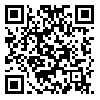Volume 3, Issue 1 (1-2021)
alkhass 2021, 3(1): 18-19 |
Back to browse issues page
Download citation:
BibTeX | RIS | EndNote | Medlars | ProCite | Reference Manager | RefWorks
Send citation to:



BibTeX | RIS | EndNote | Medlars | ProCite | Reference Manager | RefWorks
Send citation to:
Mohammadalipoor Z, Ghanadzadeh Gilani A. Prediction of Dielectric Constants of (Cyclic Ketone- 1,4-Butanediol) Binary Systems. alkhass 2021; 3 (1) :18-19
URL: http://alkhass.srpub.org/article-4-74-en.html
URL: http://alkhass.srpub.org/article-4-74-en.html
Department of Chemistry, Faculty of Science, University of Guilan, Rasht, Iran.
Abstract: (871 Views)
In order to predict the permittivity and excess permittivity data of binary systems containing cyclic ketones (cyclohexanone and cyclopentanone) and 1,4-butanediols, various mixing rules were used [1,2]. The permittivity increment, , was also evaluated in this research using the predicted data. x1 and x2 are the mole fractions of the components 1 and 2, and are the permittivities of the pure components. As shown in Fig. 1, the experimental permittivity values for three systems containing 1,4-butanediol (1,4BD) and two cyclic ketones were estimated by several mixing rules. Typically, for cyclohexanone and 1,4-butanediol mixtures, the predicted excess permittivity data were compared and shown in Fig. 2. As it can be seen from Table 1, the Lichteneker-Rother model shows the lower root mean square deviation (rmsd) value, which indicates that the Lichteneker-Rother model presents the best result between the predictive models.
Type of Study: Applicable |
Subject:
Environmental Chemistry
Received: 2020/12/15 | Revised: 2021/01/5 | Accepted: 2021/01/10 | Published: 2021/01/30
Received: 2020/12/15 | Revised: 2021/01/5 | Accepted: 2021/01/10 | Published: 2021/01/30
References
1. Ghanadzadeh Gilani A, Ramezani S. J Chem Eng Data, 2018; 63: 2888-2903. [DOI:10.1021/acs.jced.8b00217]
2. Gupta H, Chandrasekhar M, Krishna TS, Sharma VK. J Mol Liq. 2017; 231: 225-237. [DOI:10.1016/j.molliq.2017.02.011]
| Rights and permissions | |
 |
This work is licensed under a Creative Commons Attribution-NonCommercial 4.0 International License. |










